A perfectly manicured lawn is a source of pride for many homeowners. But, what happens when it’s marred by mysterious holes? It’s a frustrating problem that can be both puzzling and concerning.
Discovering small holes in your yard can be disheartening, especially if you’ve invested time and effort into maintaining its health and appearance. The causes can range from wildlife and insects to environmental conditions, making it crucial to identify the root cause before attempting a solution.
If left untreated, these holes can lead to more serious lawn damage. Fortunately, most lawn holes can be addressed with the right approach, without necessarily requiring professional help.
Key Takeaways
- Identify the cause of lawn holes before treatment
- Various factors can cause holes, including wildlife and environmental conditions
- Untreated holes can lead to more serious lawn damage
- Most lawn hole problems can be solved without professional help
- Proper identification is key to preventing future occurrences
Understanding Why You Have Lots of Small Holes in Lawn
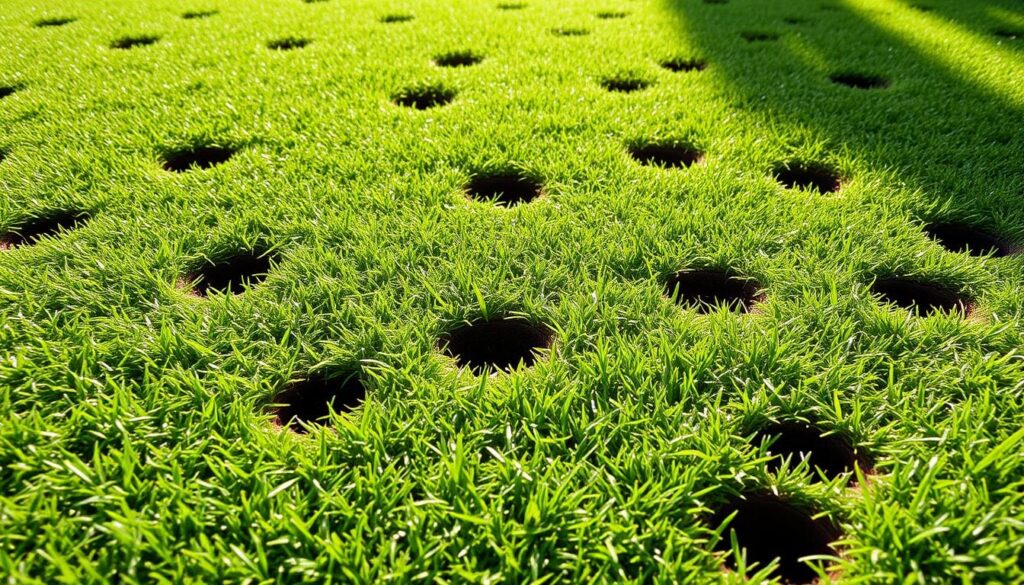
Discovering numerous small holes in your lawn can be perplexing, but understanding the underlying causes is crucial for maintaining a healthy lawn. Lawn holes can appear seemingly out of nowhere, but several known causes can lead to their formation. According to Teri Valenzuela, natural science manager at lawn care company Sunday, “Dogs digging, freshly weeded areas, wildlife like moles and voles, and stressful weather are common culprits for holes in lawns and yards.”
These small holes are often symptoms of underlying issues that can affect the overall health of your yard. The presence of holes can disrupt root systems, create uneven surfaces, and lead to water pooling or drainage issues. If left untreated, lawn holes can become entry points for weeds and further pest infestations, exacerbating the problem.
The Impact of Lawn Holes on Your Yard’s Health
The impact of lawn holes on your yard’s health can be significant. Holes can compromise the integrity of the soil, making it vulnerable to erosion and nutrient loss. Furthermore, the uneven terrain caused by holes can make lawn maintenance more challenging.
Common Signs of Lawn Damage to Look For
Beyond the presence of holes, other signs of lawn damage include wilting grass, discolored patches, and soft or spongy areas. Recognizing these signs early can help you address the underlying causes and prevent further damage. Proper lawn care practices, such as regular mowing, watering, and fertilizing, can help maintain a healthy lawn and minimize the likelihood of hole formation.
Wildlife Culprits: Animals That Dig Holes in Lawns
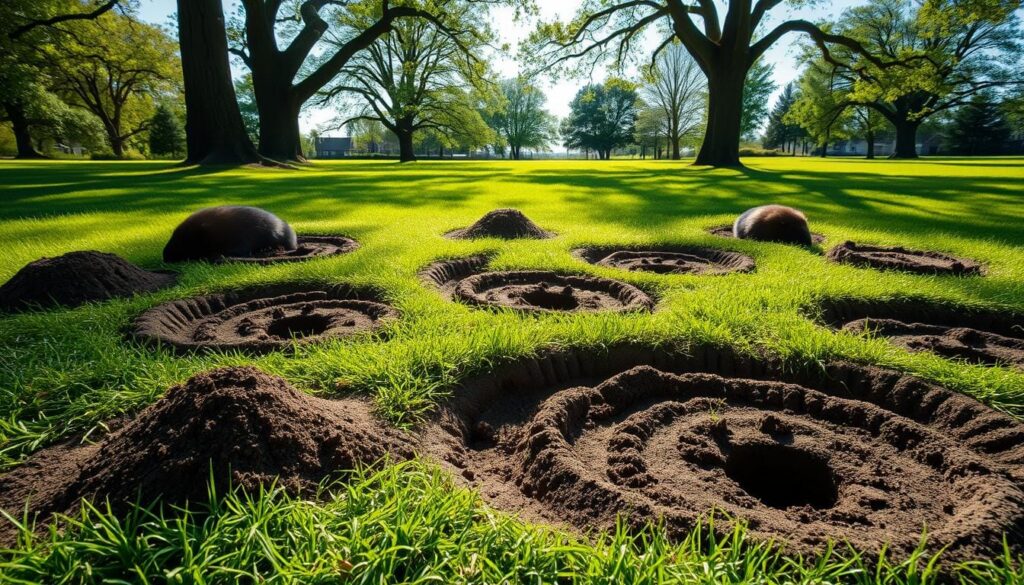
Lawns with numerous small holes are often a sign of underlying wildlife activity. Various animals are known to dig and burrow, causing damage to lawns.
Moles and Their Distinctive Tunneling Patterns
Moles create small, volcano-shaped dirt mounds when tunneling below the surface. Their tunnels are about 2 inches wide. As they search for grubs and earthworms, they can cause damage to grass roots, leading to lawn damage.
Voles: The Grass Root Destroyers
Voles bore 1 to 2-inch wide burrows near the lawn surface, which have clean, beveled edges and surface runways. They primarily feed on grass roots, resulting in dead brown patches on the lawn.
Chipmunks and Squirrels: Nut Buriers
Chipmunks and squirrels are known to dig holes in lawns, typically around 1 to 2 inches in diameter. These holes are often clean and can be found near structures or landscape features. Understanding the digging habits of these rodents can help identify the cause of lawn damage.
The seasonal patterns of wildlife digging activity can also aid in identification. While these animals can cause significant lawn damage, they are part of the broader ecosystem.
Insect-Related Holes in Your Lawn
Several types of insects are known to create holes in lawns as part of their life cycles or nesting behaviors. Understanding the characteristics of these holes and the insects responsible can help in identifying the issue and determining the appropriate course of action.
Ground-Nesting Bees and Wasps
Ground-nesting bees typically create holes that are about 1/4 inch in diameter and straight down into the soil. These bees often form dense colonies in dry, bare areas of the lawn. In contrast, wasps like yellowjackets dig holes about 1/2 inch wide to create underground nests, often with multiple entrance holes in areas with abundant food and water.
Cicada Killers and Their Burrows
Cicada killer wasps are known for digging 1/2-inch wide tunnels that go straight down into the ground. They deposit cicadas inside these burrows as food for their larvae, and the entrances may have loose soil around them. Despite their intimidating appearance, cicada killers rarely sting unless provoked.
Grubs: The Underground Lawn Destroyers
Beetle larvae, commonly referred to as grubs, feed on grass roots, weakening and damaging the turf. This damage can lead to brown patches and spongy turf. Grub infestations often attract animals like raccoons and skunks, which dig random, shallow holes searching for these protein-rich larvae.
| Insect | Hole Characteristics | Impact on Lawn |
|---|---|---|
| Ground-Nesting Bees | 1/4 inch diameter, straight down | Generally minimal |
| Yellowjackets | 1/2 inch diameter, multiple entrances | Potential hazard to humans |
| Cicada Killers | 1/2 inch diameter, loose soil around entrance | Rarely stings, beneficial in controlling cicada population |
| Grubs | Indirect damage, no visible holes | Weakens and damages turf, attracts other animals |
Environmental and Natural Causes of Lawn Holes
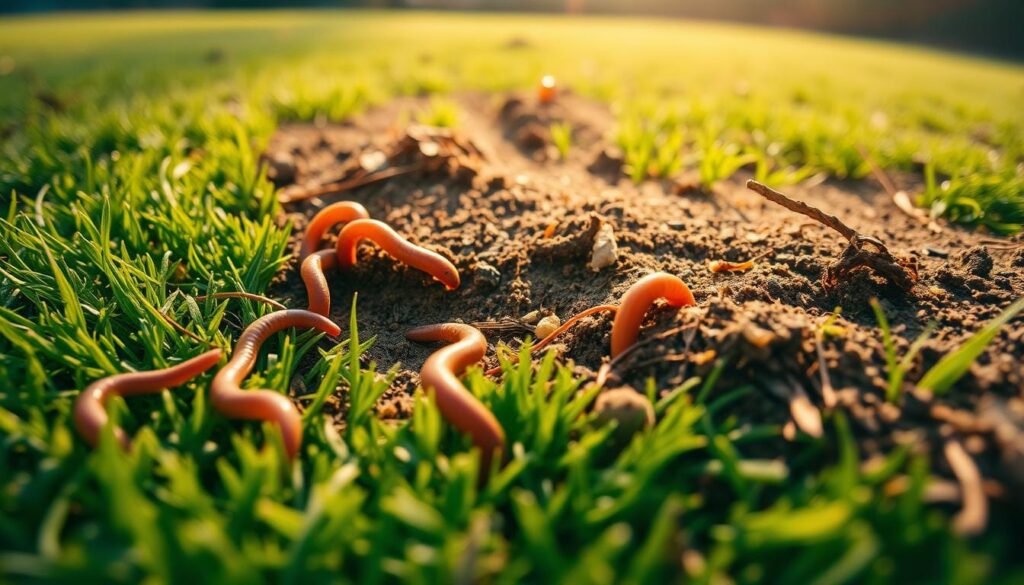
Not all lawn holes are caused by animals or insects; natural factors are also a culprit. Understanding these causes is crucial for maintaining a healthy lawn.
Earthworm Activity and Soil Health
Earthworms play a significant role in soil health by breaking down organic matter and improving soil structure. As they process this matter, they create small castings, or soil pellets, on the lawn surface. These castings are more common in spring and fall when soil moisture and temperatures are optimal for earthworm activity. Although earthworms create small holes and castings, their overall impact on lawn health is beneficial.
Weather-Related Issues and Irrigation Problems
Weather extremes, such as drought, heavy rain, and freeze-thaw cycles, can cause holes and depressions in lawns. For instance, irrigation system leaks can erode soil over time, creating sinkholes or depressions. Poor drainage can lead to water pooling, resulting in soil erosion or collapse. Additionally, thatch decomposition can sometimes create small holes as organic matter breaks down. These environmental causes often require different solutions than pest-related holes.
| Cause | Description | Impact on Lawn |
|---|---|---|
| Earthworm Activity | Creates small castings and holes as they process organic matter | Beneficial for soil health, improves soil structure |
| Weather Extremes | Can cause holes and depressions due to drought, heavy rain, or freeze-thaw cycles | Can lead to soil erosion, poor drainage, and lawn damage |
| Irrigation Leaks | Erodes soil over time, creating sinkholes or depressions | Can cause significant lawn damage if not addressed |
For more information on lawn care and hole prevention, visit Gardening Know How for expert advice.
How to Identify What’s Causing the Holes in Your Lawn
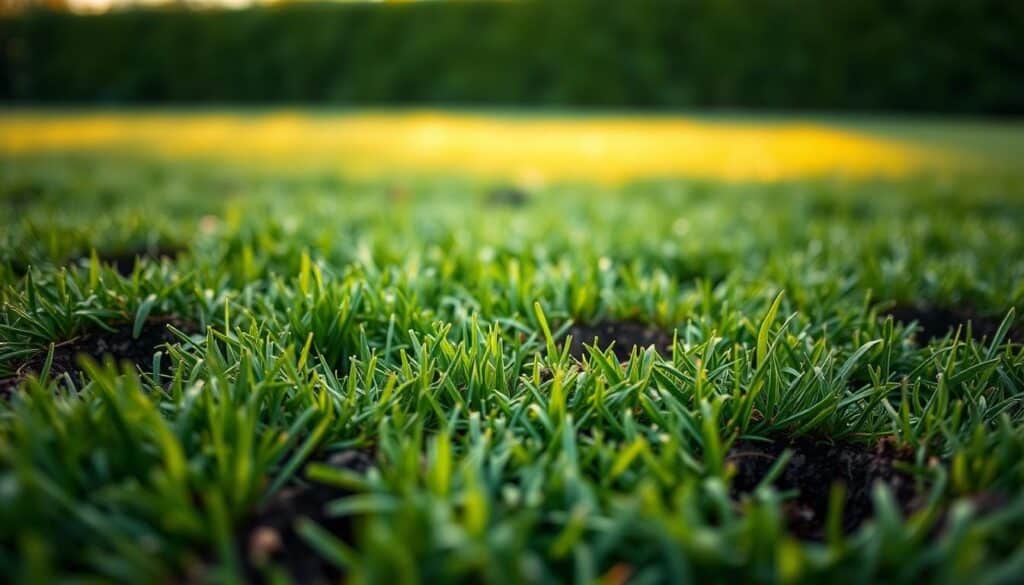
Identifying the cause of mysterious holes in your lawn can be a challenging task. To determine the culprit, it’s essential to examine the holes closely and gather clues from their characteristics and surroundings.
Size and Shape: Key Identification Factors
The size and shape of the holes can provide significant clues. For instance, small holes about 1/4 inch in diameter are often associated with ground-nesting bees, while larger holes, typically 1-2 inches, might indicate vole activity. Perfectly circular holes usually suggest insect activity, whereas irregular shapes often point to animal digging. Additionally, the presence of dirt mounds or clean holes can offer insights into the soil displacement patterns.
Timing and Location: When and Where Holes Appear
Observing the timing and location of the holes is also crucial. Holes appearing in specific areas, such as near structures or in sunny spots, can narrow down the potential causes. For example, holes near wet areas might be related to certain types of animal activity. Noting the time of year and correlating it with seasonal pest activity can also help identify the culprit.
- Assess hole size and shape for initial clues.
- Consider the timing and location of the holes.
- Look for additional evidence like tracks or damaged vegetation.
Effective Solutions for Animal-Caused Lawn Holes
Animal activity can lead to unsightly lawn holes, but effective solutions are available to homeowners. To address the issue, it’s essential to understand the cause and apply the appropriate method.
Humane Trapping and Relocation Methods
Humane trapping involves using traps that capture animals alive, without causing them harm. Wire cage traps are effective for larger mammals, while snap traps can be used for smaller rodents. However, it’s crucial to check local regulations regarding wildlife trapping and relocation.
According to the SC Department of Natural Resources (DNR), relocating trapped animals is not allowed due to disease considerations such as rabies. However, landowners with large properties can release trapped animals further away from their homes on their own property.
Natural Repellents That Actually Work
Using natural repellents can be an effective way to deter animals from digging holes in your lawn. Castor oil is known to repel moles and voles when used as a spray or granular product to saturate the affected lawn area. Other repellents include capsaicin for squirrels and predator urine for various rodents.
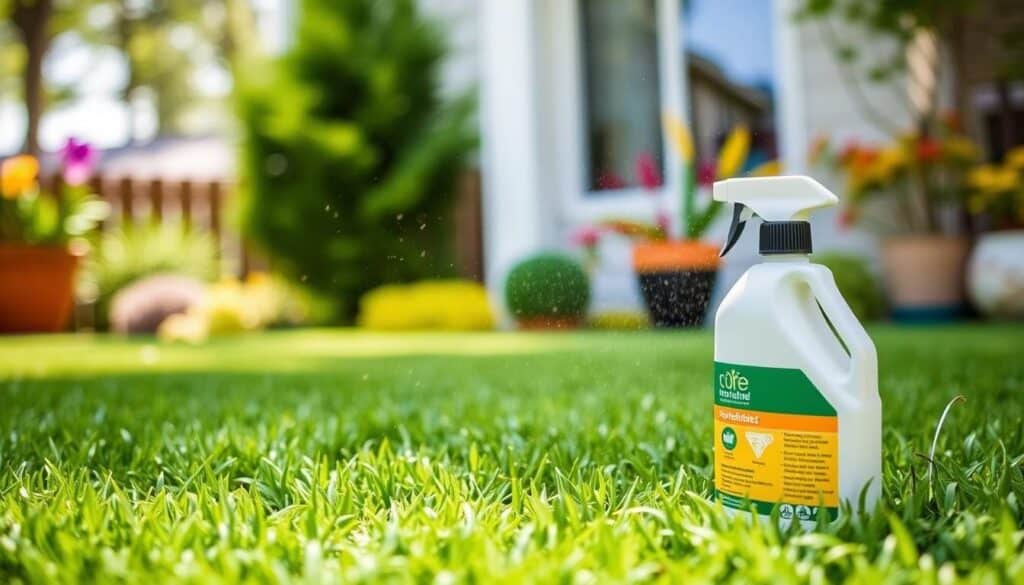
When to Call Professional Wildlife Control
If the problem persists or involves dangerous animals, it’s advisable to seek professional help. Professional wildlife control services can humanely remove nuisance wildlife from private property. The SC DNR website provides a list of current professional nuisance wildlife control operators (NWCO) for assistance.
When selecting a wildlife control professional, ensure they follow humane practices and are licensed to operate in your area.
Treating Insect-Related Lawn Damage
Treating insect-related lawn damage requires understanding the root cause and applying appropriate solutions. A two-pronged approach is often necessary, addressing both the insects causing the damage and the resulting holes in the lawn.
Biological Control Methods
Beneficial nematodes are a biological control method that can be effective against grubs and other soil-dwelling insects. These microscopic worms attack and kill insect larvae, helping to reduce lawn damage. To apply beneficial nematodes, they should be watered into the soil, typically during the summer months when grubs are most active.
Chemical Solutions for Severe Infestations
For more severe infestations, chemical solutions may be necessary. Products containing imidacloprid can be applied in May and provide season-long control of grubs. It’s essential to follow the product instructions and take necessary precautions to avoid exposure.
Cultural practices, such as maintaining proper mowing height and reducing irrigation, can also help discourage insect infestations. Repairing damaged areas through topdressing, overseeding, and proper soil preparation is crucial for restoring a healthy lawn.
An integrated pest management approach, combining multiple strategies, is key to long-term control and maintaining a healthy, pest-free lawn.
Preventing Future Holes in Your Lawn
Preventing future holes in your lawn requires a combination of good lawn care practices and environmental management. By adopting proactive strategies, you can significantly reduce the likelihood of holes appearing in your yard.
Lawn Maintenance Practices That Deter Pests
Maintaining a healthy lawn is crucial. This involves regular watering and fertilization. Mowing your grass to a height of 3 to 3.5 inches promotes stronger growth that resists pest damage. Additionally, aerating your yard once a year minimizes thatch buildup, improving soil health and reducing conditions favorable to pests.
Creating a Lawn Environment That Discourages Digging
Removing food sources is essential. This includes taking down bird feeders, removing pet food, and picking up fallen fruit from trees. Modifying your landscape can also deter digging; consider installing barriers or using gravel borders. Choosing the right grass variety for your region, one that naturally resists common pests, is also a proactive care strategy.
Conclusion
The mystery of small holes in your lawn can be solved with the right identification and treatment methods. Small holes in your yard can be caused by various factors, including wildlife, insects, and environmental factors. Proper identification is crucial before attempting any treatment to ensure the problem is addressed effectively.
Most lawn hole problems can be managed with the right approach, which includes a combination of identification, targeted treatment, and prevention. Maintaining a healthy, well-cared-for lawn through regular lawn care practices not only enhances its appearance but also makes it more resistant to damage. Over time, patience and persistence may be required as some solutions take effect.
By adopting an integrated approach to managing lawn holes, homeowners can restore their yard to its former beauty. With the right strategies and a bit of care, it’s possible to enjoy a lush, hole-free lawn.

